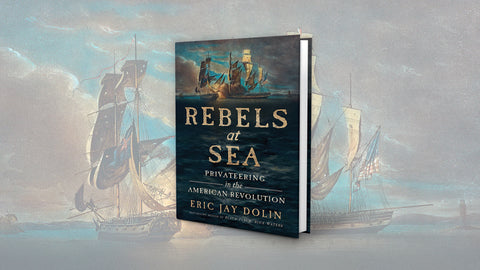
Rebels at Sea: Privateering in the American Revolution
Pirates but for a scrap of parchment, American privateers wreaked havoc on British shipping during the Revolution, contributing far more to victory at sea than the nascent U.S. Navy. Though exact records are not available, roughly 1,600 American privateers seized more than 1,800 British vessels. Privateering aligned with Americans’ spirit of free enterprise. Indeed, a mania erupted among American ship owners and sailors for taking British ships—and getting rich in the bargain.
Most naval history focuses on battles between national fleets, and so the swaggering history of the Revolution’s American privateers may have sailed past some readers. Eric Jay Dolin’s comprehensive effort helps correct that oversight.
A form of commerce raiding during the age of sail, privateering involved outfitting privately-owned ships, often converted merchantmen, with cannon, muskets, and cutlasses to “annoy” enemy commerce. The legal fig leaf for this thievery was the letter of marque—a document issued by a government giving a privateer an official commission. Seized ships, or “prizes,” were sold at special vice admiralty courts, the proceeds divvied among owners, captain, and crew. Privateer crews received a larger slice of prize sales than naval crews, making sailing on a privateer more attractive than enlisting. A single cruise could leave even lowly crewmen wealthy. Lucky privateer owners made fortunes. The privateer brig Holker of Philadelphia, dubbed “the swiftest sailing vessel…from America” by the British, took 10 prizes on one cruise. This haul was worth £2 million—today, roughly $300 million—including a sizeable profit for her owner, Irish-born merchant Blair McClenachan.
Besides examining privateer vessels, crews, and fights at sea, Dolin also studies how privateering fit American war aims, how the strategy’s popularity affected the strength of both the navy and the army, and how privateers’ successes buoyed public spirits. He also touches on how this freebooting practice discomfited certain American leaders. Benjamin Franklin, an early proponent, came to dislike privateering, calling the practice “…a remnant of the ancient piracy” and writing that it made war profitable and thus more likely.
The only drawback to Dolin’s fascinating effort might be an excess of detail on congressional political machinations and the Revolution’s general history and not enough on the exciting sea stories and battle accounts of these partisans-for-profit. —T
Pirates but for a scrap of parchment, American privateers wreaked havoc on British shipping during the Revolution, contributing far more to victory at sea than the nascent U.S. Navy. Though exact records are not available, roughly 1,600 American privateers seized more than 1,800 British vessels. Privateering aligned with Americans’ spirit of free enterprise. Indeed, a mania erupted among American ship owners and sailors for taking British ships—and getting rich in the bargain.
Most naval history focuses on battles between national fleets, and so the swaggering history of the Revolution’s American privateers may have sailed past some readers. Eric Jay Dolin’s comprehensive effort helps correct that oversight.
A form of commerce raiding during the age of sail, privateering involved outfitting privately-owned ships, often converted merchantmen, with cannon, muskets, and cutlasses to “annoy” enemy commerce. The legal fig leaf for this thievery was the letter of marque—a document issued by a government giving a privateer an official commission. Seized ships, or “prizes,” were sold at special vice admiralty courts, the proceeds divvied among owners, captain, and crew. Privateer crews received a larger slice of prize sales than naval crews, making sailing on a privateer more attractive than enlisting. A single cruise could leave even lowly crewmen wealthy. Lucky privateer owners made fortunes. The privateer brig Holker of Philadelphia, dubbed “the swiftest sailing vessel…from America” by the British, took 10 prizes on one cruise. This haul was worth £2 million—today, roughly $300 million—including a sizeable profit for her owner, Irish-born merchant Blair McClenachan.
Besides examining privateer vessels, crews, and fights at sea, Dolin also studies how privateering fit American war aims, how the strategy’s popularity affected the strength of both the navy and the army, and how privateers’ successes buoyed public spirits. He also touches on how this freebooting practice discomfited certain American leaders. Benjamin Franklin, an early proponent, came to dislike privateering, calling the practice “…a remnant of the ancient piracy” and writing that it made war profitable and thus more likely.
The only drawback to Dolin’s fascinating effort might be an excess of detail on congressional political machinations and the Revolution’s general history and not enough on the exciting sea stories and battle accounts of these partisans-for-profit. —Tim Queeney is editor of Ocean Navigator magazine in Portland, Maine.
This book review appeared in the Autumn 2022 issue of American History magazine.
Rebels at Sea: Privateering in the American Revolution
By Eric Jay Dolin
Liveright, 2022
This post contains affiliate links. If you buy something through our site, we might earn a commission.
